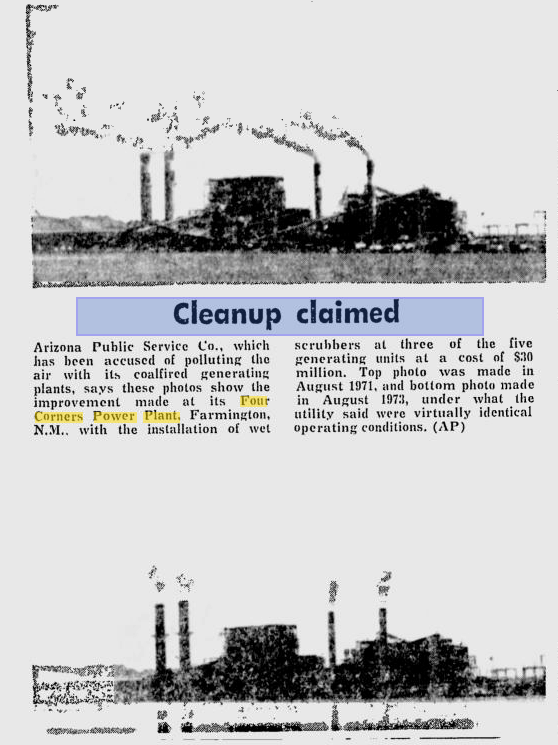The Cuyahoga River used to catch on fire. The Four Corners Power Plant plume was visible half way to the Moon.
The Clean Air and Clean Water Acts were critical pieces of legislation – from the days when the EPA was actually concerned about the environment, rather than simply functioning as a fund raising extension of the Internal Revenue Service



That’s kinda funny. From 1971 to 1974 I was employed measuring the pollution coming out of the stacks of the Four Corners Power Plant.
1. The plume was never visible from outer space. See the study done by meteorologist Loren Crow — what was visible were shadows of contrails. Four Corners, and San Juan, and the new one (whatever its name) are under the jetways from Dallas to Los Angeles. What the astronauts saw, what the cameras caught, were the shadows of the contrails. Among other tell-tales, the Sun’s angle at the time of the photos.
2. Though particulates were cleaned up by the original improvements, there were still high levels of sulfur oxides and nitrogen oxides, and aerosols that contributed to visibility restrictions throughout the region, including the Grand Canyon. In short, while the most visible emissions were controlled by 1973, that was only part of the story. More scrubbers and other controls were required to reduce the gaseous, more damaging pollution (SO2 and NOx do severe damage to desert plants).
3. Odd, to me, that you’d acknowledge some of the effects of the Clean Air Act, while denying the spurs to get the law passed in other threads. The Clean Air Act of 1970 required controls of particulates, but the Clean Air Amendments of 1977 struck right at the “invisible” emissions from these power plants in the Southwest with the rule requiring “prevention of significant deterioration” in clean air. Prior to that, the power companies (including APS) argued that they could dump a lot of pollution before violating clean air standards.
Environmental writers, among them Garrett Hardin, Paul Ehrlich, Wallace Stegner and Ed Abbey, contributed greatly to mobilizing public opinion to get the laws passed.
Edward Abbey? The guy who wrote about blowing up Glen Canyon Dam….. Thanks for letting us know who your heroes are.
Yeah, he wrote The Monkey Wrench Gang, too. You didn’t read it, I take it.
Abbey was a great writer. Most people read Desert Solitaire, however — which is a reflective, non-fiction work.
If Abbey isn’t one of your writing heroes, you’re not fully American. Wallace Stegner, too.
Suggesting Abbey to be a problem for writing Monkey Wrench Gang is like suggesting Twain to be a communist for Huck Finn, or Steinbeck a radical for Grapes of Wrath. If you don’t care about humans, you won’t like Abbey.
I see, so you support environmental terrorism as a core American value.
No, I’m an ambassador for reading comprehension and straight up U.S. history — which is why I bother at all here. You need so much help in both areas.
Only Ehrlich and you suffered from the pollution in the 1960s. The rest of us idiots were too dumb to know not to shit in our own beds.
Ignorance is a curable condition. You could read Abbey now, or Leopold, or Stegner, or Tempest Williams, or others.
I read all of Abbey’s books in the 1980s. He was advocating environmental terrorism.Hayduke was an environmental terrorist. Why are you supporting these ideas?
Like I said: Reading comprehension difficulties.
Abbey powerfully advocated preserving natural wonders, protecting the environment, and wrote with great humor about monkeywrenching — which can be distinguished from terrorism by the fact that people are not harmed by monkeywrenching (business profitlines might suffer, but surely you don’t deny the spiritual value of things).
I worry that you don’t appear to have distinguished between environmental protection, which also protects and extends and enriches human life and existence, and environmental “terrorism,” however you define it. Tantamount to condemning capitalism completely for having utilized child labor.
Wikipedia has Hayduke as I remember him:
So, you used to go cliff diving in Powell, but you repudiate saving the lake, and you repudiate getting rid of the lake, and you repudiate almost everything about the lake and the Southwest and especially paying attention to the ecosystems and greater hydrology systems of the area. You repudiate Green Berets . . . what is there about America that you actually like and appreciate, Steve?
Like blowing up Glen Canyon dam and sabotaging construction equipment.